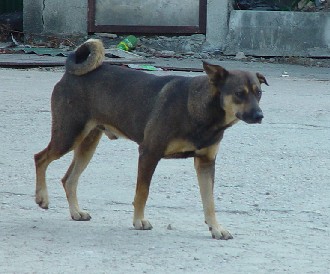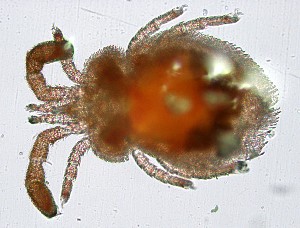
| INSIDE THIS ISSUE | Pilot Study on Maintaining Rat-Free Villages Anti-rodent Campaign 2006 | Prevention on Scrub Typhus and Tick-borne Spotted Fever |
|---|
Pilot Study on Maintaining Rat-Free Villages
Anti-rodent Campaign 2006
Introduction
Rodents are pests that can cause physical damage to properties and contaminate food stuff. They can also transmit a number of diseases.
The Food and Environmental Hygiene Department (FEHD) carries out anti-rodent inspections and rodent control measures throughout the territory. To sustain the anti-rodent control work, interdepartmental and territory-wide anti-rodent campaigns are conducted each year. These campaigns remind the public of the importance of rodent prevention through a spectrum of publicity instruments.

Staff of FEHD and Sha Tin District Office visited Ngau Pei Sha Village (Sha Tin)
Rodent problems
Rodent can live on minimal amount of food and is a pest highly adaptive to live with humans. It is highly reproductive and re-infestation will soon occur after disinfestations if rodent proofing measures and sustainable rodent control work have not been implemented. Community participation is essential for sustaining the results on rodent control, no matter how much resource the Government has deployed to tackle the problem.
The activities of rat in public areas can be reflected by the Rodent Infestation Rate, which is calculated from the percentage of rat bait consumed by rodent (Number of bait consumed by rodent/Total number of bait retrieved x 100% = Rodent Infestation Rate). Over the last few years, rodent control has gained some success and the situation has been improving. The rodent infestation rate dropped from 16% in year 2000 to 4.6% in year 2005 (up to 11/2005). However, there are still rooms for enhancement. Improper disposal of food remnants, incorrect handling of disused articles and inadequate maintenance of building fixtures/facilities are often the causes of failure in sustaining the results in rodent control.
Pilot study
A combination of approaches including "block control" and "permanent baiting" has been successfully adopted for rodent control in Budapest, Hungary. "Block control" refers to rodent control in a physically bound area, whereas "permanent baiting" prevents the proliferation of rodent remained or intruded from the surrounding areas after a rodent disinfestations operation by setting poisonous rodent bait in the area or surrounding areas permanently. "Rat-free" condition is achievable and sustainable in Budapest. The percentage of premises in Budapest found infested with rodents was less than 0.5% since early 1970s.
During the Anti-rodent Campaign 2006, FEHD will incorporate into it a pilot study on combining the approaches of "block control" and "permanent baiting" in controlling rodents in six semi-rural villages. The pilot study, as part of the Anti-rodent Campaign 2006, has commenced on 9.12.2005. With active participation of the residents, pest control staff of FEHD will conduct comprehensive rodent control actions inside the buildings and common areas of the selected villages by applying poisonous baits against rodent. The whole village will be protected from invasion of rodents by permanent baiting along the periphery of the village.
The rodent infestation rate in the areas will be maintained at low level by rodent control measures including poisonous baiting, environmental hygiene improvement, installation of rodent proofing measures etc. Regular evaluation would be conducted to review the rodent situation for a period of 12 months. The objectives of the pilot study are to reduce rodent population, to maintain low rodent infestation rate for a prolonged period and to establish mode of operation for long-term effective control of rodents. The pilot study also aims to assess the scale of support required, including manpower requirements, technical know-how, publicity etc. for implementing a sustainable rodent control and prevention programme. If it is found successful, the approach adopted will be promulgated to other localities, the housing estates for example.
Selected villages for the pilot study
Semi-rural small residential areas with buildings of 1 to 4 storeys are selected. The six villages that have been selected to engage in the pilot study are -
- Shek O Village (Shek O),
- Cha Kwo Ling Tsuen (Kwun Tong),
- Tseung Kwan O Village (Tseung Kwan O),
- Ngau Pei Sha Village (Sha Tin),
- Sam Tung Uk Resite Village including Hoi Pa Resite Village (Tsuen Wan),
- San Hui Village (Tuen Mun).
Advice to villagers
The villagers are advised to take rodent prevention measures. The rodent prevention measures are as follows -
- Remove food sources for rodents
- Keep premises clean and tidy.
- Dispose of food remnants and refuse properly in covered rubbish bins which have to be cleared daily.
- Complete removal of pet food after feeding.
- Eliminate harbourgaes for rodents
- Avoid accumulation of disused articles both inside and outside the building.
- Maintain the drains and sewer systems in good conditions and replace broken drains and manhole covers.
- Seal any holes at roofs, on walls and on floors
- Trim the vegetation around the building regularly
- Exclude rodents from outside
- Use metal plates or cements to seal all openings on external walls, floors and roofs through which pipes and wires pass or left by installation of split-type air conditioners.
- Lower the threshold clearance of doors to not more than 6 mm and install metal kicking plates at least 30 cm high in the lower edge of doors and door frames.
- Install wire meshes with an aperture not larger than 6 mm for vents, exhaust fans and ventilation louvers.
- Seal all defective pavements with cement.
Appoint a pest control company for handling rodent problems.
Prevention on Scrub Typhus and Tick-borne Spotted Fever
Contracting rodent-borne diseases in local rural areas is uncommon but does occur. The number of cases reported last year (2005) increased when comparing to the past years. A total of 40 cases (28 were scrub typhus and 12 were tick-borne spotted fever ) were reported in year 2005 while there were 29 cases in 2004. Among the 40 patients, 26 had gone hiking or visiting rural areas during the incubation period of the diseases in 2005. Of the rodent-borne diseases, transmission of scrub typhus and tick-borne spotted fever tend to occur more commonly in rural areas. Mites and ticks are the arthropods which may carry the pathogens capable of causing these diseases. These arthropods usually cluster at tips of grasses/scrubby areas for easy attachment on the bodies of animals and passers-by.

stray dog

stray dog

scrubby area
Infectious Agents:
Scrub Typhus: Orientia tsutsugamushi
Tick-borne spotted fever: Rickettsia conorii
Vectors:
| Scrub Typhus: | Larval stages of chigger mites; Leptotrombidium akamushi, Leptotrombidium deliensis can transmit the disease. The disease is able to be circulated and maintained by transmitting the infectious agent to the offspring of mites1. |
|---|---|
| Tick-borne spotted fever: | One of the principal vectors of the disease is brown dog tick, Rhipicephalus sanguineus, but ticks of most ixodid genera can transmit the disease. The brown dog tick, Rhipicephalus sanguineus, is occasionally found in local stray dogs and pet dogs. |

adult chigger mite (Trombicula spp.)
Mode of transmission:
| Scrub Typhus: |
The disease can be transmitted by the bite of infected larval stages of chigger mites. Larval mites move to the body of human who walks through long grasses or scrub vegetation2. Nymphs and adults do not feed on vertebrate hosts. |
|---|---|
| Tick-borne spotted fever: |
The disease can be transmitted by the bite of infected Rhipicephalus sanguineus. Contamination of breaks in the skin or mucous membranes with crushed tissues or faeces of the ticks may also lead to infection1. |
Preventive measures against contracting these diseases.
- Applying insect repellent with 10-30% concentration of DEET(N, N-diethyl-meta-toluamide) on exposed skin as well as clothing. Pay close attention to the product label, especially regarding the use for children.
- Wearing light coloured long sleeved clothes and long trousers
- Avoiding resting or lying on scrubby areas
- Avoiding hanging clothes on scrubs or trees
- Avoiding brushing the long grasses beside the paths
- Avoiding feeding or approaching stray dogs
- Avoiding applying odour-producing cosmetic such as perfume / body lotion during outdoor activities
- Disinfesting your pets regularly
- Inspecting and disinfesting your pet beddings regularly
- Keeping your premises clean and tidy
- Trimming of vegetation particularly the grass in your premises
References:
- Abram S. Benenson, etal, Control of Communicable Diseases Manual, American Public Health Association, 1995.
- M.W. Service, A Guild to Medical Entomology, The Macmillan Press Ltd., 1980
- 黎家燦、王敦清、陳興保。中國恙蟎(恙虫病媒介和病體研究)。廣州科技出版社,1997
More informaiton on pest prevention and control can be obtained from other pages of our website